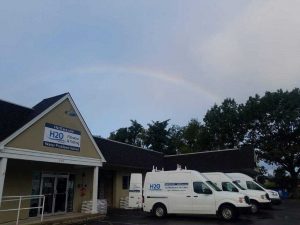
Commercial Water Treatment Solutions
Water treatment is any process that improves the quality of water to make it more acceptable for a specific end-use. The end use may be drinking, industrial water supply, irrigation, river flow maintenance, water recreation or many other uses, including being safely returned to the environment.

Commercial Twin Softener System (Large Capacity) Installed in Hospital
Water softener technology is the same for a house as it is for a large hospital. However, a large disparity in volume requirements can make the design, installation, planning and service more complicated. When sizing a water softening system for commercial application, doing the math and getting reasonably accurate volume demand information in gallons is critical to determining the size of the commercial water softener or softeners. Water softening resin has a finite amount of water that it can soften before it needs to go into a backwash (or self cleaning) cycle to clean the resin beads for continued softening. Additionally, determining the size of the brine tank for softener salt storage is also very important to keep the tank filling requirements at a reasonable level for the personnel maintaining this.

High Efficiency Water Softener
Space available for the equipment is another important consideration. To avoid a long piping run to and from the system, a good location needs to be selected. Additionally, any space restrictions will need to taken into consideration when sizing both the softener and brine tank sizes.
When are twin softeners needed in a commercial setting?
In a hospital setting or other setting where water is being used essentially 24 hours per day, a back up softener may be required. The main reason for this is when one softener goes into its backwash cycle, the second softener will be able to provide a steady supply of softened water to the facility. Without this backup, unconditioned water will be pulled through the system while the softener is in the backwash cycle. In the photo at the top of the page, this system is feeding make-up water to the boiler. It has to be clean water 24 hours a day.
Water Treatment for Bad Tastes, Odors & Sediment

Point of Entry System
In addition to the above systems, there are many other types of systems to remove bad tastes & odors, sediment and many other objectionable minerals and contaminants in the water. Starting with a water test will dictate the right approach. Larger commercial environments may require a back-washing sediment filter versus cartridge style replaceable filters. For more information on common bad odors & tastes in New England water supplies, see the link at http://bad-odor-taste-water/. For more on hard water, see https://water.usgs/edu/hardness.
REMOVAL OF PFAS IN WATER

PFAS Removal System
There are technologies effective in removing PFAS from drinking water, especially Perfluorooctanoic acid (PFOA) and Perfluoro octane sulfonic acid (PFOS), which are the most studied of these chemicals. The most effective technologies include ion exchange, activated carbon adsorption and reverse osmosis. For whole house filtration of PFAS, Ion exchange is proving to be a better approach. See link for more detail on removal options at https://h2ocare.com/what-are-pfas/


